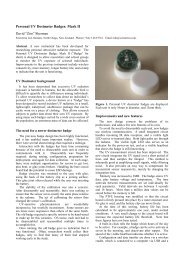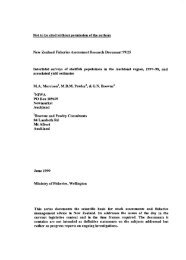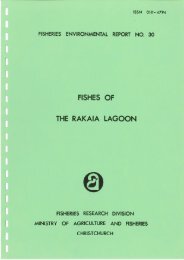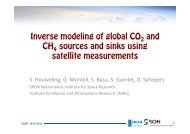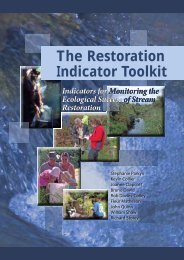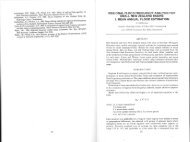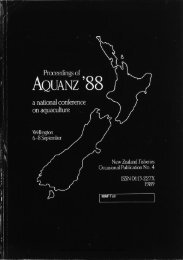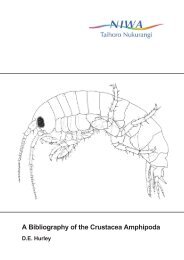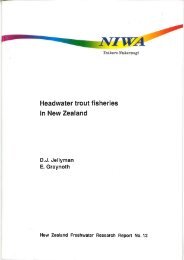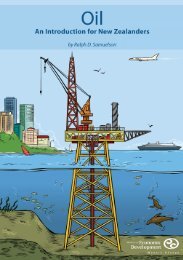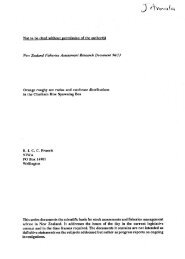WATER & SOIL - These are not the droids you are looking for.
WATER & SOIL - These are not the droids you are looking for.
WATER & SOIL - These are not the droids you are looking for.
You also want an ePaper? Increase the reach of your titles
YUMPU automatically turns print PDFs into web optimized ePapers that Google loves.
data <strong>for</strong> this <strong>are</strong>a <strong>are</strong> required be<strong>for</strong>e a decision can be<br />
made whe<strong>the</strong>r to make <strong>the</strong> <strong>are</strong>a a region in itself or to include<br />
it in <strong>the</strong> surrounding region.<br />
The second sub-region identified is <strong>the</strong> <strong>are</strong>a south-west of<br />
Nelson in <strong>the</strong> South Island West Coast region (see Figures<br />
3.7 and 3.22). lt was of interest in that <strong>the</strong> flood peall data<br />
<strong>for</strong> two flow stations (sites 57008 and 57101) in <strong>the</strong> <strong>are</strong>a did<br />
<strong>not</strong> con<strong>for</strong>m at all to <strong>the</strong> regional flood frequency trend;<br />
<strong>the</strong>se stations were omitted from <strong>the</strong> derivation of <strong>the</strong> regional<br />
curve. The non-con<strong>for</strong>mity of <strong>the</strong> data was thought<br />
to be due to <strong>the</strong> fact that <strong>the</strong> <strong>are</strong>a is in a rain-shadow, caused<br />
mainly by <strong>the</strong> Sou<strong>the</strong>rn Alps to <strong>the</strong> west, and receives<br />
significantly less rainfall than <strong>the</strong> o<strong>the</strong>r parts of <strong>the</strong> region.<br />
<strong>These</strong> factors encouraged a detailed look at <strong>the</strong> flood frequency<br />
behaviour in <strong>the</strong> whole <strong>are</strong>a,<br />
The flood peak data that were collected <strong>for</strong> <strong>the</strong> <strong>are</strong>a according<br />
to <strong>the</strong> criteria in sections 3.2.1 and 3.2.2,toge<strong>the</strong>r<br />
with extra data that did <strong>not</strong> meet <strong>the</strong>se criteria but were<br />
never<strong>the</strong>less thought to be of some use here, were pooled<br />
toge<strong>the</strong>r to <strong>for</strong>m a probability plot <strong>for</strong> <strong>the</strong> <strong>are</strong>a. All <strong>the</strong> data<br />
used in <strong>the</strong> plot <strong>are</strong> summarised in Table 3.5, while <strong>the</strong> extra<br />
data <strong>are</strong> listed in full in Appendix C.<br />
The probability plot that was obtained <strong>for</strong> <strong>the</strong> Nelson<br />
<strong>are</strong>a, and <strong>the</strong> curve that was fitted to <strong>the</strong> plotted data, <strong>are</strong><br />
shown in Figure 3.23. Despite <strong>the</strong> inadequacies with <strong>the</strong><br />
data and <strong>the</strong> small number of flow stations used it would<br />
seem, both from <strong>the</strong> trend in <strong>the</strong> probability plot and from<br />
<strong>the</strong> large difference between <strong>the</strong> fitted curve and <strong>the</strong> South<br />
Island West Coast regional curve (shown as <strong>the</strong> dashed line<br />
in Figure 3.23), that <strong>the</strong>re is some justification <strong>for</strong> treating<br />
<strong>the</strong> <strong>are</strong>a south-west of Nelson as a separate sub-region, and<br />
<strong>not</strong> part of <strong>the</strong> surrounding region. A greater amount of re-<br />
Iiable data is needed to confirm this point and to define <strong>the</strong><br />
<strong>are</strong>a's own regional curve with confidence. In <strong>the</strong> meantime,<br />
however, it is suggested that <strong>the</strong> regional curve <strong>for</strong> <strong>the</strong><br />
South Island East Coast region should be used <strong>for</strong> <strong>the</strong> <strong>are</strong>a<br />
ra<strong>the</strong>r than <strong>the</strong> one <strong>for</strong> <strong>the</strong> South Island West Coast region.<br />
The <strong>for</strong>mer region is drier and has a steeper frequency<br />
curve and hence is more in keeping with <strong>the</strong> Nelson <strong>are</strong>a.<br />
3.3.7 General¡sed flood frequency curves<br />
From all <strong>the</strong> flood peak data assembled <strong>for</strong> this study,<br />
two generalised flood frequency curves extending to high<br />
return periods were developed. In recognition of <strong>the</strong> differences<br />
in <strong>the</strong> characteristics of <strong>the</strong> regional curves <strong>for</strong> <strong>the</strong><br />
west and east of New Zealand, one generalised curve was<br />
developed <strong>for</strong> <strong>the</strong> western <strong>are</strong>as (Regions I and 5) and one<br />
<strong>for</strong> <strong>the</strong> eastern <strong>are</strong>as (Regions 2,3, 4,6, 7 and 8). The development<br />
was based on <strong>the</strong> principle utilised by Stevens<br />
and Lynn (1978) of pooling regional data toge<strong>the</strong>r to obtain<br />
more stable flood estimates <strong>for</strong> high return periods. With<br />
<strong>the</strong> large base of pooled data <strong>for</strong> each generalised curve, it<br />
was hoped that <strong>the</strong> curves could be extended to <strong>the</strong> 1000-<br />
year return period with sufficient accuracy to be useful in<br />
design.<br />
<strong>These</strong> curves incorporated many of <strong>the</strong> historical flood<br />
peaks that were excluded from <strong>the</strong> regional analyses under<br />
Rule (lli) of section 3.2.2. ln general, this rule was invoked<br />
in a regional analysis because a flood peak was an extreme<br />
outlier and <strong>the</strong> available length of flood record at <strong>the</strong> station<br />
concerned was insufficient <strong>for</strong> <strong>the</strong> computation of a<br />
plausible return period <strong>for</strong> that flood peak. However, <strong>the</strong>re<br />
were good reasons <strong>for</strong> including here some of <strong>the</strong> previously<br />
excluded historical peaks: <strong>the</strong> large base of data <strong>for</strong><br />
each curve, toge<strong>the</strong>r with <strong>the</strong> use of <strong>the</strong> extension method,<br />
would help to prevent <strong>the</strong>se peaks from exerting undue bias<br />
on <strong>the</strong> shape of <strong>the</strong> curves; and as <strong>the</strong> curves were to be extended<br />
to <strong>the</strong> 1000-year return period, <strong>the</strong> flood peaks with<br />
return periods approaching this limit should be used, where<br />
possible.<br />
All but four of <strong>the</strong> previously excluded extreme peaks<br />
were considered suitable <strong>for</strong> <strong>the</strong> development of <strong>the</strong> generalised<br />
curves, The remaining four peaks were truly extreme<br />
events, and even tbe large bases of data associated with <strong>the</strong><br />
generalised curves were insufficient to enable realistic return<br />
periods to be ascribed to <strong>the</strong>m. Two of <strong>the</strong> peaks occurred<br />
in <strong>the</strong> same storm in 1938 in <strong>the</strong> adjacent Mohaka<br />
Table 3.6 Calculations <strong>for</strong> extending <strong>the</strong> sets of average values<br />
<strong>for</strong> <strong>the</strong> generalised curves.<br />
(a) The Maximum O/O and y values.<br />
Western New Zealand<br />
Group 1 Group 2 Group 3 Group 4<br />
o/o<br />
4.58 7.13<br />
2.94 6.11<br />
2.91 5.61<br />
2.74 5.28<br />
o/o<br />
4.84 7.O7<br />
2.62 6.O5<br />
2.59 5.55<br />
2.45 5.22<br />
yo/OyO/Oy<br />
M= 7OO 661 659<br />
No. of Stat¡ons<br />
: 23 15<br />
Eastern New Zealand<br />
2.99 7.O7 3.90 7.13<br />
2.58 6.05 3.25 6.1 1<br />
2.46 5.55 2.81 5.61<br />
2.40 5.22 2.49 5.28<br />
700<br />
Group 1 Group 2 Group 3 Group 4<br />
o/o o/o o/o o/o<br />
3.12 6.68<br />
2.87 5.65<br />
2.74 5.15<br />
2.54 4.42<br />
4.31 6.68<br />
4.06 5.66<br />
3.65 5.1 6<br />
3.55 4.83<br />
4.62 6.69 3.85 6.83<br />
3.82 5.66 3.75 5.80<br />
2.99 5.17 3.53 5.31<br />
2.A7 4.83 3.06 4.98<br />
M= 444 448 450 517<br />
No. of Stations<br />
= 14<br />
19<br />
(bl Classification and averages of <strong>the</strong> maximum O/O and y values.<br />
t5<br />
t3<br />
Table 3.5 Summary of flow stations in <strong>the</strong> Nelson a¡ea.<br />
Site No. Flow Station Catchment No. Annual<br />
Area (km'zl (and historical)<br />
flood peaks<br />
56901 Riwaka River at Moss Bush<br />
57002 Motueka River at Baton Br.<br />
57006 Wangapeka River at Swing Br.<br />
57OOB Motueka River at Gorge<br />
57009 Motueka River at Woodstock<br />
571O1 Moutere River at Old House Rd.<br />
571OG Stanleybrook River at Barkers<br />
48<br />
'1647<br />
373<br />
163<br />
1750<br />
60.7<br />
81<br />
10<br />
18<br />
I<br />
9<br />
8<br />
10<br />
7<br />
y lnterval<br />
Wefem NZ:<br />
7.O - 7.5<br />
6.5 - 7.0<br />
6.0 - 6.5<br />
5.5 - 6.0<br />
5.0 - 5.5<br />
Eaetem NZ:<br />
6,5 - 7.O<br />
6,0 - 6.5<br />
5.5 - 6.0<br />
5.0 - 5.5<br />
4.5 - 5.O<br />
No. of values Average O/O Average y<br />
4<br />
4<br />
4<br />
4<br />
4<br />
4<br />
4<br />
4<br />
4.O8<br />
2.85<br />
2.69<br />
2.52<br />
3.98<br />
3.63<br />
3.23<br />
3.O2<br />
7.10<br />
6.08<br />
5.58<br />
5.25<br />
6.72<br />
569<br />
520<br />
487<br />
42<br />
Water & soil technical publication no. 20 (1982)



